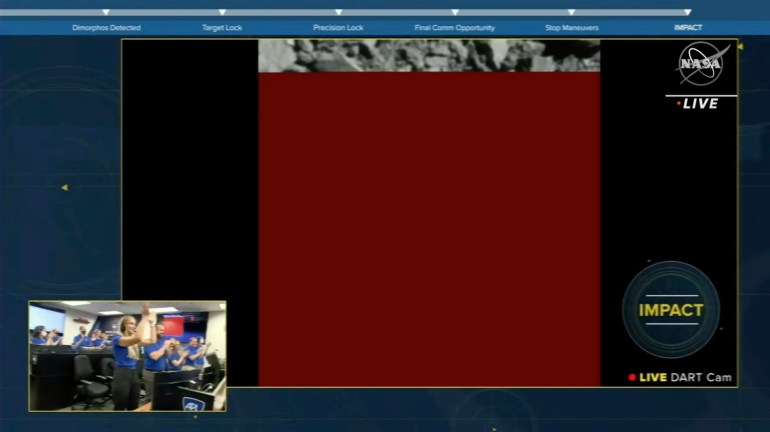NASA spacecraft collides with asteroid in planetary defence test
In world’s first attempt to change the direction of an asteroid, scientists hope the method can prevent collisions with Earth.

A NASA spacecraft has hit an asteroid in an unprecedented test designed to prevent potentially devastating collisions with Earth.
NASA’s Double Asteroid Redirection Test (DART) spacecraft crashed into the asteroid Dimorphos about 11 million kilometres (6.8 million miles) from Earth at about 23:00 GMT on Monday.
Keep reading
list of 3 itemsNASA launches ‘suicide’ spacecraft to kick asteroid off course
Three tonnes of space junk on a collision course with the moon
The US space agency livestreamed the test from the mission operations centre outside Washington, DC, showing images taken by DART’s own camera as the cube-shaped “impactor” vehicle, no bigger than a vending machine with two rectangular solar arrays, careered into Dimorphos, an asteroid about the size of a football stadium.
Cheers could be heard from engineers in the control room as second-by-second images of the target asteroid grew larger and ultimately filled the TV screen of NASA’s live webcast just before the spacecraft’s signal was lost, confirming it had crashed into Dimorphos.
“Impact confirmed for the world’s first planetary defense test mission,” said a graphic that appeared on the live stream.
The mission was devised to determine whether a spacecraft can alter the trajectory of an asteroid through sheer kinetic force, nudging it off course just enough to keep Earth out of harm’s way.

Its success will not be known until further ground-based telescope observations are completed next month.
“This is a challenging test, and this is why we’re taking these first steps now to develop this technology before we need it,” Nancy Chabot, the mission coordination lead, told Al Jazeera hours before the scheduled impact.
The DART spaceship launched from California in the United States last November, and has made most of its journey with the guidance of NASA flight directors.
There was a heightened sense of anticipation as the craft approached its target.
“It’s the final cosmic collision countdown,” tweeted mission control at the Johns Hopkins University Applied Physics Laboratory in the US state of Maryland.
The asteroid did not post a risk to Earth, but the test marks the first effort to change the trajectory of an asteroid using only kinetic force, and scientists hope that the method could be used to nudge asteroids and prevent cataclysmic collisions.
“If this works, then we know we can use that same technology to deflect asteroids that might pose an actual threat further down the line,” Tanya Harrison, a fellow at the Outer Space Institute in Seattle told Al Jazeera.
A camera sent back images during the final approach and collision.
The target was an asteroid “moonlet” that orbits an asteroid about five times larger, called Didymos.
Smaller asteroids are more common and therefore a greater concern in the near term, making the Didymos pair suitable test subjects for their size, according to NASA scientists and planetary defence experts.
🛰️ This is only a test – of planetary defense. Today, our #DARTMission is set to crash into a non-hazardous asteroid to test deflection technology, should we ever discover a threat.
Impact: 7:14pm ET (23:14 UTC). Watch our LIVE broadcast at 6pm ET: https://t.co/VAfF5ZXcYB pic.twitter.com/czGqnYJIGJ
— NASA (@NASA) September 26, 2022
Their relative proximity to Earth and dual-asteroid configuration also make them strong subjects for the first proof-of-concept mission of DART.
The DART team hopes to shorten the orbital track of Dimorphos by 10 minutes but would consider at least 73 seconds adequate to prove that the method could be used to deflect asteroids.
The cost of the project is estimated to be about $330m, far below many of NASA’s more ambitious space missions.
DART is the latest of several NASA missions in recent years focused on exploring asteroids, rocky remnants from the solar system’s formation more than 4.5 billion years ago.